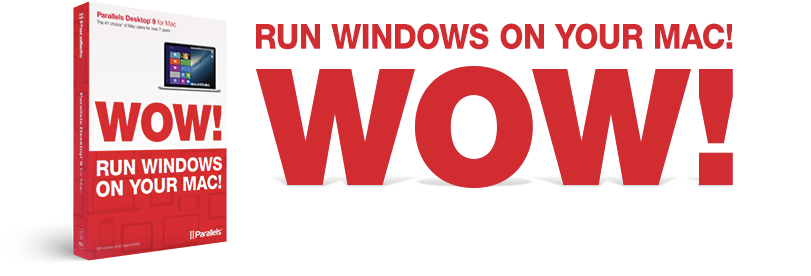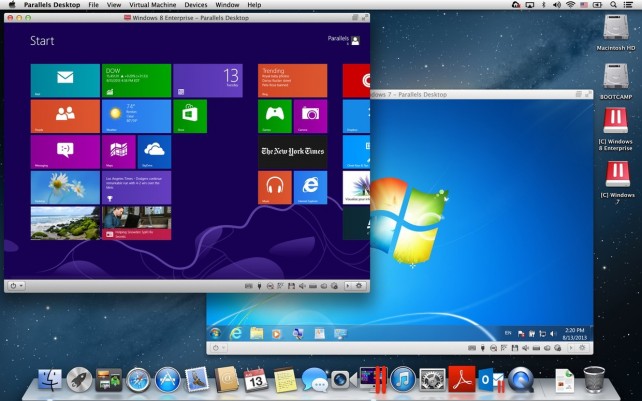It is never easy to make a choice between two very comparable products, is it? Parallels Desktop 9 and VMware Fusion 6 have just appeared with a week of each other, both have support for Windows 8.1 and the imminent OS X 10.9 Mavericks and both claim enhanced features and improved speed. The big question is which one do you choose? Well, here at Techbeat we like you arm you lovely people with all the information you need to make an informed decision. So here is a rundown of what you need to know about Parallels 9 and a smidgen of info about Fusion 6.

Both Parallels and Fusion perform the same basic functions. Each runs Windows operating system as a “virtual machine,” (for the less informed among you, this means that a version of Windows can exist on your Mac entirely in software window) A disk file is a “virtual” hard disk for your Windows system, and an OS X window is its virtual monitor. The virtual machine is tightly integrated with your OS X system.
You can run Windows applications, (or if you like, the complete Windows desktop), on your OS X desktop and drag and drop files, text and images between Windows and OS X. You can use all your peripherals inside Windows. Both pieces of software here provide integration between OS X and Windows. For example, by default, both set up Windows so that when you type Command C or Command V to copy and paste, which are the standard keystrokes on the Mac, Windows acts as if you typed Ctrl C and Ctrl V, the standard copy/paste keystrokes in Windows. It is impossible to make keyboard settings like these match perfectly between OS X and Windows, and Parallels and Windows provide slightly different defaults, but you can modify the default settings to suit your requirements. However, for the standard user, things are set out rather well.

Parallels starts as soon as you launch it and run its New Virtual Machine wizard. You get a six ways to create a virtual machine, either by downloading free operating system like Chrome OS from Google, or Ubuntu Linux or letting the wizard download and install the free Windows 8.1 Preview. You can also create a virtual version of your current OS X system, giving you a clean, fresh copy of Lion or Mountain Lion.
Other available options let you install an operating system from a DVD or a downloaded disk-image file, or create a virtual version of an existing Windows PC by transferring its contents across a network. (This migration option requires you to reactivate Windows with a new activation key that you’ll need to buy from Microsoft. Also, it is a lengthy process) Before you get too excited about Parallels’ ability to open Metro-style Windows 8 apps in a window and the provision for a Windows 7-style start menu, bear in mind that Parallels just uses Stardock’s Start8 and Modern Mix utilities, which you can buy and install in any Windows 8 setup.
Parallels Desktop and VMware Fusion are by a long way the best software for running Windows under OS X. For beginners, Parallels is easier to use and install and sets itself up by default for the tightest possible integration, but advanced users may prefer Fusion. Parallels does have a broader feature set, but Fusion has a less intrusive style.
Now you are armed to the teeth with info, the decision is yours to make.

Both Parallels and Fusion perform the same basic functions. Each runs Windows operating system as a “virtual machine,” (for the less informed among you, this means that a version of Windows can exist on your Mac entirely in software window) A disk file is a “virtual” hard disk for your Windows system, and an OS X window is its virtual monitor. The virtual machine is tightly integrated with your OS X system.
You can run Windows applications, (or if you like, the complete Windows desktop), on your OS X desktop and drag and drop files, text and images between Windows and OS X. You can use all your peripherals inside Windows. Both pieces of software here provide integration between OS X and Windows. For example, by default, both set up Windows so that when you type Command C or Command V to copy and paste, which are the standard keystrokes on the Mac, Windows acts as if you typed Ctrl C and Ctrl V, the standard copy/paste keystrokes in Windows. It is impossible to make keyboard settings like these match perfectly between OS X and Windows, and Parallels and Windows provide slightly different defaults, but you can modify the default settings to suit your requirements. However, for the standard user, things are set out rather well.

Parallels starts as soon as you launch it and run its New Virtual Machine wizard. You get a six ways to create a virtual machine, either by downloading free operating system like Chrome OS from Google, or Ubuntu Linux or letting the wizard download and install the free Windows 8.1 Preview. You can also create a virtual version of your current OS X system, giving you a clean, fresh copy of Lion or Mountain Lion.
Other available options let you install an operating system from a DVD or a downloaded disk-image file, or create a virtual version of an existing Windows PC by transferring its contents across a network. (This migration option requires you to reactivate Windows with a new activation key that you’ll need to buy from Microsoft. Also, it is a lengthy process) Before you get too excited about Parallels’ ability to open Metro-style Windows 8 apps in a window and the provision for a Windows 7-style start menu, bear in mind that Parallels just uses Stardock’s Start8 and Modern Mix utilities, which you can buy and install in any Windows 8 setup.
Parallels Desktop and VMware Fusion are by a long way the best software for running Windows under OS X. For beginners, Parallels is easier to use and install and sets itself up by default for the tightest possible integration, but advanced users may prefer Fusion. Parallels does have a broader feature set, but Fusion has a less intrusive style.
Now you are armed to the teeth with info, the decision is yours to make.

0 comments:
Post a Comment